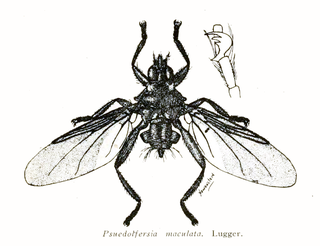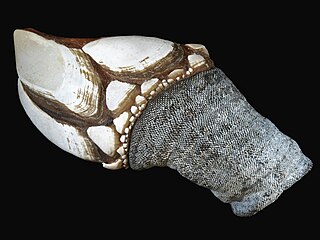William Elford Leach was an English zoologist and marine biologist.

Charles Alexandre Lesueur was a French naturalist, artist, and explorer. He was a prolific natural-history collector, gathering many type specimens in Australia, Southeast Asia, and North America, and was also responsible for describing numerous species, including the spiny softshell turtle, smooth softshell turtle, and common map turtle. Both Mount Lesueur and Lesueur National Park in Western Australia are named in his honor.
John Cranch (1785–1816) was an English naturalist and explorer.

Nebalia is a large genus of small crustaceans containing more than half of the species in the order Leptostraca, and was first described by William Elford Leach in 1814. The genus contains over thirty species:

Ibacus peronii, the Balmain bug or butterfly fan lobster, is a species of slipper lobster. It lives in shallow waters around Australia and is the subject of small-scale fishery. It is a flattened, reddish brown animal, up to 23 cm (9 in) long and 14 cm (6 in) wide, with flattened antennae and no claws.

Squillidae is a family of mantis shrimp, the only family in the superfamily Squilloidea. The type genus is Squilla. It is the stomatopod family with the most genera, as follows:

Olfersia is a genus of biting flies in the family of louse flies, Hippoboscidae. The genus was erected by William Elford Leach in 1817. There are seven known species, and all are parasites of birds.

Crustaceans may pass through a number of larval and immature stages between hatching from their eggs and reaching their adult form. Each of the stages is separated by a moult, in which the hard exoskeleton is shed to allow the animal to grow. The larvae of crustaceans often bear little resemblance to the adult, and there are still cases where it is not known what larvae will grow into what adults. This is especially true of crustaceans which live as benthic adults, more-so than where the larvae are planktonic, and thereby easily caught.

Pollicipes is a genus of goose barnacles, first described by William Elford Leach in 1817. It comprises four species of marine suspension-feeders.

Praunus is a genus of mysid shrimp, comprising three species:

Polybius henslowii is a species of crab, the only species in the genus Polybius. It is a capable swimmer and feeds in open water in the north-east Atlantic Ocean and western Mediterranean Sea.
Ixa is a genus of Indo-Pacific pebble crabs from the family Leucosiidae. The genus was erected by William Elford Leach in 1816. One species, the Red Sea pebble crab, is a Lessepsian migrant and the species was first described to science from specimens collected on the Mediterranean Sea although the species is native to the Red Sea and had colonised the eastern Mediterranean through the Suez Canal.

Caprella penantis is a species of skeleton shrimp in the family Caprellidae. It lives on the seabed in shallow water in many parts of the world. This species was first described in 1814 by the English zoologist William Elford Leach who named it Caprella penantis in honour of the Welsh naturalist Thomas Pennant. The type locality is Devon, England.

Chydorus is a genus of Chydoridae.

Mictis is a genus of sap-sucking insects in the family Coreidae, with species recorded from India, China, Vietnam and Malesia through to Australia. It was described by William Elford Leach in 1814.

Rocinela is a genus of isopods in the family Aegidae, and was first described in 1818 by William Elford Leach. The type species is Rocinela danmoniensis Leach, 1818.
Alima neptuni is a species of shrimp in the Squillidae family, and was first described in 1768 by Carl Linnaeus as Cancer neptuni.
Alima pacifica is a species of shrimp in the Squillidae family, and was first described in 2001 by Shane Ahyong.
Alima maxima is a species of shrimp in the Squillidae family, and was first described in 2002 by Shane Ahyong.
Athanas sydneyensis is a species of small alpheid shrimp.












